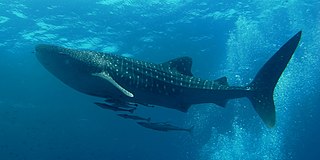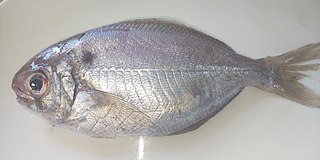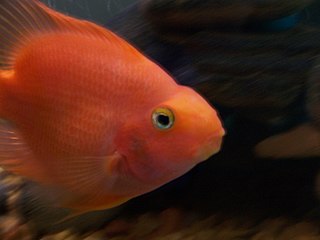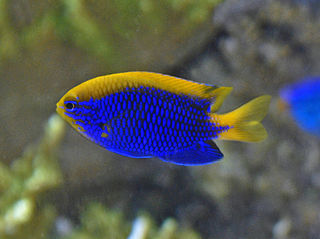
Perch is a common name for fish of the genus Perca, freshwater gamefish belonging to the family Percidae. The perch, of which three species occur in different geographical areas, lend their name to a large order of vertebrates: the Perciformes, from the Greek: πέρκη, simply meaning perch, and the Latin forma meaning shape. Many species of freshwater gamefish more or less resemble perch, but belong to different genera. In fact, the exclusively saltwater-dwelling red drum is often referred to as a red perch, though by definition perch are freshwater fish. Though many fish are referred to as perch as a common name, to be considered a true perch, the fish must be of the family Percidae.

Calamansi, also known as calamondin, Philippine lime, or Philippine lemon, is an economically important citrus hybrid predominantly cultivated in the Philippines. It is native to the Philippines, Borneo, Sumatra, and Sulawesi in Indonesia in Southeast Asia, as well as southern China and Taiwan in East Asia. Calamansi is ubiquitous in traditional Filipino cuisine. It is naturally very sour, and is used in various condiments, beverages, dishes, marinades, and preserves. Calamansi is also used as an ingredient in Malaysian and Indonesian cuisines.

The milkfish is the sole living species in the family Chanidae. However, there are at least five extinct genera from the Cretaceous. The repeating scientific name (tautonym) is from Greek khanos.

The whale shark is a slow-moving, filter-feeding carpet shark and the largest known extant fish species. The largest confirmed individual had a length of 18.8 m (61.7 ft). The whale shark holds many records for size in the animal kingdom, most notably being by far the largest living nonmammalian vertebrate. It is the sole member of the genus Rhincodon and the only extant member of the family Rhincodontidae, which belongs to the subclass Elasmobranchii in the class Chondrichthyes. Before 1984 it was classified as Rhiniodon into Rhinodontidae.

The cobia is a species of carangiform marine fish, the only representative of the genus Rachycentron and the family Rachycentridae. Other common names include black kingfish, black salmon, ling, lemonfish, crabeater, prodigal son, codfish and black bonito.

The grass carp is a large, herbivorous, freshwater fish species of the family Cyprinidae native to eastern Asia, with an original range from northern Vietnam to the Amur River on the Siberia-China border. This Asian carp is the only species of the genus Ctenopharyngodon.

The yellowfin tuna is a species of tuna found in pelagic waters of tropical and subtropical oceans worldwide.

The Pacific rudderfish is a marine fish also known by such names as Japanese butterfish, melon seed, wart perch, ibodai or simply but ambiguously as butterfish.

The prickly shark is one of the two species of sharks in the family Echinorhinidae, found in the Pacific Ocean over continental and insular shelves and slopes, and in submarine canyons. Bottom-dwelling in nature, it generally inhabits cool waters 100–650 m (330–2,130 ft) deep, but it also frequently enters shallower water in areas such as Monterey Bay off California. This stocky, dark-colored shark grows up to 4.0 m (13.1 ft) long, with two small dorsal fins positioned far back on its body and no anal fin. It is characterized by a dense covering of thorn-like dermal denticles, hence its common name.

The yellowtail horse mackerel, also known as the yellowtail scad, is a jack in the family Carangidae found around Australia and New Zealand at depths to 500 m. Its length is up to 50 centimetres (20 in). The yellowtail scad is the only member of the monotypic genus Atule and is distinguished from similar species by a well-developed adipose eyelid and finlet-like extensions of the last rays of the dorsal and anal fins. It inhabits coastal areas such as bays and coral reefs, preying on small fishes and crustaceans. The yellowtail scad is an important component of fisheries throughout its range, taken by a number of netting and hook-and-line methods. It is a prized food fish in some regions and is cooked or preserved by a variety of methods.

The blood parrot cichlid is a hybrid thought to be between the midas and the Gold Severum cichlid, although the true parent species has not been confirmed by breeders. The fish was first bred in Taiwan around 1986. Blood parrots should not be confused with other parrot cichlids or salt water parrotfish. Natural colors of the fish are red, yellow, and grey: other colors are injected by breeders.

The blotchy swellshark, or Japanese swellshark, is a common species of catshark, belonging to the family Scyliorhinidae. The Blotchy swellshark is found at depths of 90–200 m (300–660 ft) in the northwestern Pacific Ocean, from Japan to Taiwan. It is benthic in nature and favors rocky reefs. Reaching 1.4 m (4.6 ft) in length, this thick-bodied shark has a broad head, large mouth, and two unequally-sized dorsal fins positioned far back past the pelvic fins. It can be identified by its dorsal coloration, consisting of seven brown "saddles" and extensive darker mottling on a light tan background. This species has often been confounded with the draughtsboard shark and the Sarawak pygmy swellshark in scientific literature.

The blacktip sawtail catshark is a species of catshark, and part of the family Scyliorhinidae, found off the coasts of Taiwan and the Philippines. It is demersal in nature and occurs deeper than 60 m (200 ft). Growing up to 46 cm (18 in) long, this slim-bodied species is characterized by its plain brownish dorsal coloration with dark tips on the dorsal and caudal fins, and a prominent crest of enlarged dermal denticles on the upper edge of the caudal fin. It is oviparous, with females producing encapsulated eggs two at a time year-round. The blacktip sawtail catshark is caught incidentally in bottom trawls and used for fishmeal in Taiwan.
Bathygadus garretti is a species of rattail. This is a deep-water fish found in the waters around southern Japan and northern Taiwan.
Bathygadus nipponicus is a species of rattail. This is a deep-water fish found in the waters around southern Japan and northern Taiwan.
Pseudocetonurus septifer is a species of rattail, the only known species in the genus Pseudocetonurus. This fish is found at depths of up to 950 m in the waters around Hawaii and in the south-eastern Pacific. It has recently also been recorded on the other side of the Pacific, near Taiwan, and this species probably has a pan-Pacific distribution but has been underrecorded due to the depths in which it lives.

The giant trevally, also known as the lowly trevally, barrier trevally, giant kingfish or ulua, is a species of large marine fish classified in the jack family, Carangidae. The giant trevally is distributed throughout the tropical waters of the Indo-Pacific region, with a range stretching from South Africa in the west to Hawaii in the east, including Japan in the north and Australia in the south. Two were documented in the eastern tropical Pacific in the 2010s, but it remains to be seen if the species will become established there.

Sillago is a genus of fish in the family Sillaginidae and the only non-monotypic genus in the family. Distinguishing the species can be difficult, with many similar in appearance and colour, forcing the use of swim bladder morphology as a definitive feature. All species are benthic in nature and generally coastal fish, living in shallow, protected waters although there are exceptions. Minor fisheries exist around various species of Sillago, making them of minor importance in most of their range. This genus has the widest distribution of any smelt-whiting genus, spanning much of the Indo-Pacific. The genus ranges from the east coast of Africa to Japan in the east and Southern Australia in the south, with most species concentrated around South East Asia, the Indonesian Archipelago and Australia. Many species have overlapping distribution, often making positive identification hard.

The tawny fish owl is a fish owl species in the family known as typical owls, Strigidae. It is native from southern Nepal to Bangladesh, Vietnam and China. Due to its wide geographical distribution, it is listed as Least Concern on the IUCN Red List.

Chrysiptera starcki is a species of damselfish known by the common name Starck's demoiselle. It is native to the western Pacific Ocean, where it has been reported from the Ryukyu Islands and Taiwan to Australia, New Caledonia, and Tonga. It was originally described in 1973 as Abudefduf starcki.

















